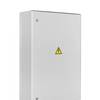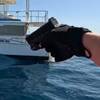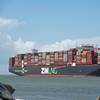New Sloshing Guidelines for LNG Cargo
Lloyd's Register, the world leader in the classification of LNG carriers, has published a new guidance document for the design of membrane-technology liquid natural gas containment systems.
The document is aimed at improving design procedures with respect to sloshing forces, and is the result of a long program of research and development, including extensive consultation with industry, and an investment of over $1,1m. The document has been used as part of the appraisal process for the approval of the largest LNG carrier built to date – the Q-Max type ships, of which Lloyd’s Register is the lead class.
Sloshing is the motion of a fluid in a partially filled tank which may in sometimes be violent. The principal factors that affect the behavior of the fluid motion are the tank shape, fill height and the ship’s motions. As a consequence of this motion high impact forces can occur on the tank boundaries and this document concerns itself with the design procedures necessary to assess the strength of the tank boundary to these sloshing impacts.
“Sloshing Assessment Guidance Document for Membrane Tank LNG Operations” provides guidance and recommendations on the assessment of sloshing in membrane LNG tanks. It provides design teams with an overview of suitable procedures for assessing the strength of Gaztransport and Technigaz NO96, Mark III cargo containment systems (CCS) and also new containment systems.
Nigel White, Technical Manager, Hydrodynamics, with Lloyd's Register’s Marine Product Development team, says, “LNG sloshing is a very complex issue as there are many aspects that are difficult to address explicitly by calculation or testing. Consequently, the assessment of the cargo containment system of membrane LNG ships for sloshing loads is very complicated and there is no single definitive assessment procedure that may be applied. The new document is written as guidance and it provides best engineering practice on the assessment of the CCS and the supporting hull structure.
“Several levels of assessment method are possible and these procedures reflect an increasing complexity of analysis which can provide better design assurance. This document gives an overview of these alternative assessment methods with recommended procedures that can be applied. It is then the responsibility of the designer to select appropriate procedures.”
The guidance mainly applies to membrane tank LNG ships with a barred fill range typical of the vast majority of membrane tank LNG ships in current operation. It can also be applied for the assessment of membrane tank LNG ships at offshore terminals or for LNG ships with no barred fill range. The document can also form the basis of a sloshing assessment procedure for in-depth investigation on other ship types that store or transport liquefied or liquid cargoes in large tanks and which are expected to experience significant sloshing loads. These include:
• Moss spherical tank LNG ships
• LPG ships
• Offshore storage or production vessels, e.g. FLNG, FSRU applications using membrane (or independent) LNG tanks.
Prior to 2008, the design assessment of the membrane ship containment system was undertaken on the basis of a comparative sloshing assessment procedure, as described in Lloyd’s Register’s document, “ShipRight Comparative Sloshing Assessment SDA Procedure-April 200.” In this procedure, the assessment of the CCS was on the basis of predicting the design sloshing loads using an extensive model test program and did not cover the explicit assessment of CCS strength aspects. Since then, the rapid increase in ship size, and hence cargo tank size, has rendered this approach inadequate.
Recently there have been several incidents involving damage to LNG membrane tanks and the approach adopted in the document provides guidance on the processes necessary to ensure that these incidents will not recur. Hence, as part of the design process, the designer should undertake a risk assessment and a hazard review to determine all possible failure modes. Having done this, it is then possible to set suitable design appraisal methods and acceptance criteria to show that these potential hazards are clearly controlled.
The document gives guidance to the designer on the use of the following assessment methods:
• model testing or computational fluid dynamics (CFD) or a combination of both to derive the sloshing loads
• linear and non linear dynamic finite element analysis of the CCS and the supporting hull structure supported by physical testing to derive the structural response and ultimate capacity of the system
• assessment methods based on extreme value analysis or structural reliability analysis techniques.
Further information, and copies of the Sloshing Assessment Guidance Document for Membrane Tank LNG Operations, can be obtained from:
Nigel White, Technical Manager – Hydrodynamics
Lloyd's Register Marine Product Development
Tel. +44 (0)20 7423 1698
Fax +44 (0)20 7423 2061
E-mail [email protected]










